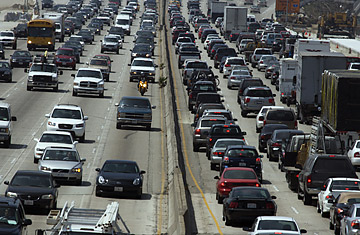
Rush hour freeway traffic heading north and south on the San Diego 405 Freeway in West Los Angeles.
If you bought a car after September 2007, you might have experienced sticker shock — but not the sort that involves price.
A little less than two years ago the Environmental Protection Agency (EPA) decided to revise the tests it uses to determine the official fuel-economy rating for new automobiles. It was no secret that before the revision, the actual gas mileage delivered by a new car tended to be significantly lower than what was promised by the official "window sticker" ratings. That's because they were based on the EPA's old tests, which involved little more than steady driving — without the use of air conditioning or anything else that might increase gasoline consumption.
The EPA's new tests account for faster driving, acceleration and deceleration and air-conditioning use — in other words, the way most real people drive. As a result fuel-economy ratings have dropped about 12% for city driving and about 8% for highway driving. When the new tests kicked in, a 2006 Toyota Prius, for instance, went from having a 55 m.p.g. combined efficiency rating to 46 m.p.g. — overnight.
The change was a good idea — not least because it gave drivers a more accurate measure of how much they'd end up spending at the pump. So, you would expect that the Corporate Average Fuel Economy (CAFE) ratings — the industry-wide minimum standards that the government uses to push automakers to improve gas mileage — would also use the updated tests. But guess what? They don't. (See TIME's special report on Global Warming.)
The CAFE standard is the average annual fuel efficiency for a manufacturer's entire fleet; automakers have to meet that standard or pay a fine. But the current measured CAFE standards, nationally, of about 27.5 m.p.g. for cars and 22.2 m.p.g. for light trucks has little to do with real-world performance. John DeCicco, the automotive expert for the Environmental Defense Fund (EDF), estimates that in actual driving, the current measured CAFE standard, for cars, is closer to 22 m.p.g, and, for trucks, closer to 18 m.p.g. "It's longstanding common knowledge that the government has been keeping two sets of books on fuel economy for decades," DeCicco says.
That's partly due to the fact that while the EPA rates the fuel economy of vehicles on a model-by-model basis, the calculation of CAFE falls to the National Highway Transportation and Safety Administration (NHTSA), part of the Department of Transportation. Under the laws that have created and modified CAFE, the NHTSA isn't allowed to revise its tests — meaning it's stuck using tests that haven't really been updated since CAFE was established in 1975.
In 2007, greens fought hard to mandate an increase in the CAFE standards. They won a half-victory — the 2007 energy bill gradually raises the CAFE standard for cars to at least 35 m.p.g. by 2020. That's the first mandated increase in two decades — but the U.S. standards still lag behind those of Europe and Japan, and barely keep pace with China's. And, yet, that increase — against which foot-dragging U.S. automakers fought hard, complaining about the cost of meeting higher fuel efficiency standards — required compromises, which forced the NHTSA to keep using the old rules. "It's a shame that when this law was passed no one in the government went up and measured what was actually going on," says DeCicco. (Read "Heroes of the Environment.")
Still, DeCicco points out, even if the CAFE numbers don't reflect reality, by raising the standard to 35 m.p.g., it mandates a relative increase in fuel economy of about 40%. But the government's double bookkeeping still matters — especially with the NHTSA set to issue final regulations that will help guide automakers to meet the new standard. An EPA analysis from September shows that the 35-m.p.g. CAFE standard will translate to 27 to 28 m.p.g. under real-world conditions — about the same fuel efficiency that the current CAFE standard purports to enforce. "The program is undermined and the public confidence in policymakers is undermined," says Mike Walsh, the former head of the EPA's office of transportation and air quality. "The real benefit of savings from oil and greenhouse gas emissions is a lot less than what they think."
It also matters to the economy — although oil prices have plummeted in recent weeks, the International Energy Agency just issued a report predicting the inevitable return of triple digit oil prices. And it matters to climate change — more than 20% of U.S. carbon emissions come from road vehicles.
It seems, then, that one of the U.S. government's few actions on climate change would turn out to be mostly a mirage.
